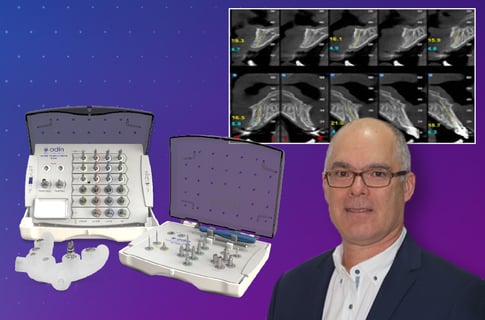 Utilizing two guides for efficient implant placement and immediate loading
Utilizing two guides for efficient implant placement and immediate loading
The patient is a 35-year-old man, suffering from severe medical conditions that contraindicate any open-flap surgery.
In 2014, he fell and badly injured teeth 12-11-21.
At that time, to prevent surgery, root canal treatments were performed in these teeth and they were restored with crowns.
At the end of 2020, he complained that teeth 12-11 were not stable, and felt "funny".
In a radiograph it was obvious that teeth 12-11 suffer from external resorption.
It was clear than that there is no way but to extract teeth 12-11.
Under strict medical supervision, the two teeth were extracted, and he received a temporary partial denture which he did not like, and therefor asked for a fixed solution.
After three months of healing, a CBCT of the area was obtained.
The ridge at the site was slightly resorbed, and the crestal width measured 4-5mm.
Due to his medical condition, and in order to avoid open-flap surgery, Adin's guided surgery was used.
Two Adin Touareg CloseFit™ NP 3.0mm were planned to ensure maximum bone surrounding the implants, A secondary prosthetic guide, with two provisional crowns was also planned, to perform immediate loading at the time o f implant placement.
On follow-up visits it was obrious that the gingival tissues were healed appropriately, restoring form and function of the treated area.

Post accident condition.
2014

Crowns at 6 years follow-up.
2020

External resorption.
2020

CBCT of the area.

A model showing buccal tissue deficiency.
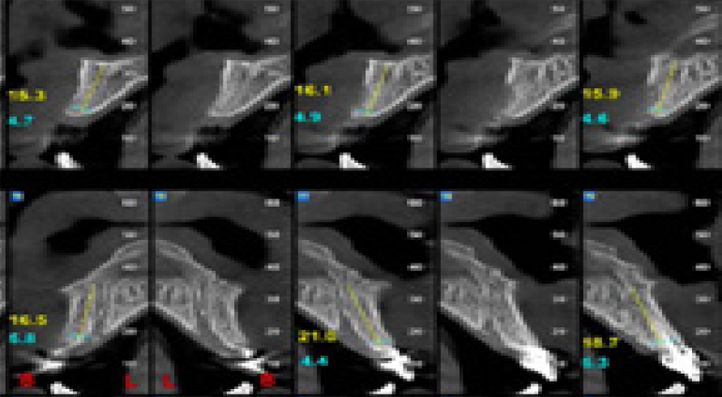
Bone evaluation.
CBCT

Implant placement plan.

Surgical guide.

 Prosthetic guide.
Prosthetic guide.
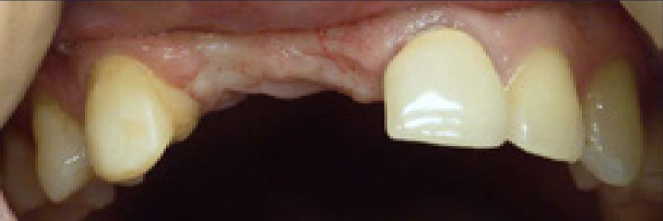

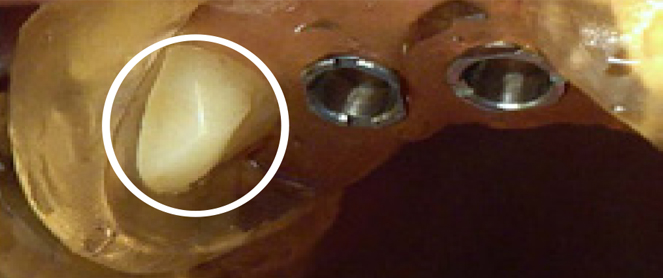 Guide evaluation and adjustment to ensure correct seating before surgery.
Guide evaluation and adjustment to ensure correct seating before surgery.

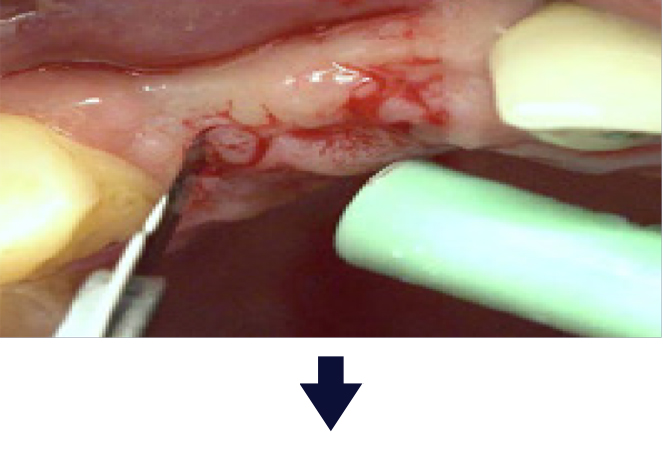
 Tissue punch and removal of soft tissue.
Tissue punch and removal of soft tissue.
 Pilot drill.
Pilot drill.
 Implant drill.
Implant drill.
 Parallel pins.
Parallel pins.
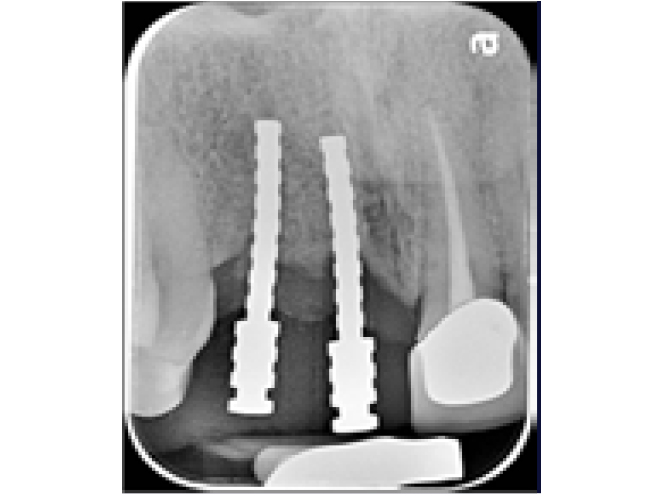 Parallel pins.
Parallel pins.
 Implant placement through the guide.
Implant placement through the guide.
 Insertion torque assessment to evaluate the ability to perform immediate loading.
Insertion torque assessment to evaluate the ability to perform immediate loading.
 The two implants in place.
The two implants in place.
 Secondary, prosthetic guide evaluation and adjustment to ensure correct seating.
Secondary, prosthetic guide evaluation and adjustment to ensure correct seating.
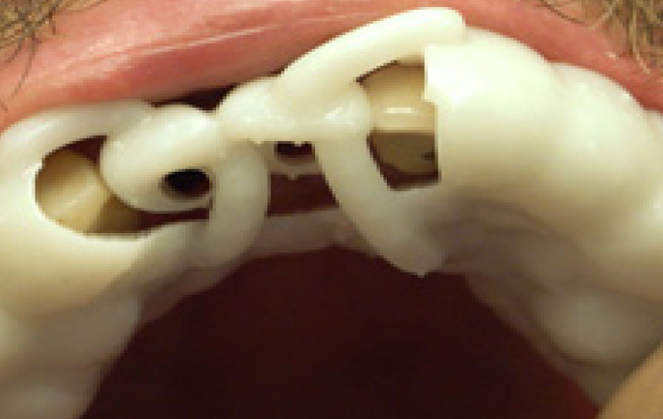 Secondary, prosthetic guide In place.
Secondary, prosthetic guide In place.
 Temporary abutments connected to implants.
Temporary abutments connected to implants.
 Validation of secondary, prosthetic guide seating with no direct contact with temporary abutments.
Validation of secondary, prosthetic guide seating with no direct contact with temporary abutments.
 Application small amount of acrylic resin to the temporary abutments.
Application small amount of acrylic resin to the temporary abutments.
 Application small amount of acrylic resin to the provisional crowns.
Application small amount of acrylic resin to the provisional crowns.
 Seating and holding the secondary, prosthetic guide in place to ensure correct connection to the temporary abutments.
Seating and holding the secondary, prosthetic guide in place to ensure correct connection to the temporary abutments.
 Unscrewing of provisional crowns and finilizing acrylic resin apposition around temporary abutments.
Unscrewing of provisional crowns and finilizing acrylic resin apposition around temporary abutments.


 Separating provisional crowns from the guide and shape adjustment outside of the mouth.
Separating provisional crowns from the guide and shape adjustment outside of the mouth.
 Try-in of provisional crowns in mouth.
Try-in of provisional crowns in mouth.
 Adjustments of shape and occlusion in the mouth.
Adjustments of shape and occlusion in the mouth.
 Adjustments of shape and occlusion in the mouth ensuring no direct contact with adjacent teeth.
Adjustments of shape and occlusion in the mouth ensuring no direct contact with adjacent teeth.
 Color adjustments.
Color adjustments.
 Delivery of provisional, immediate crowns.
Delivery of provisional, immediate crowns.
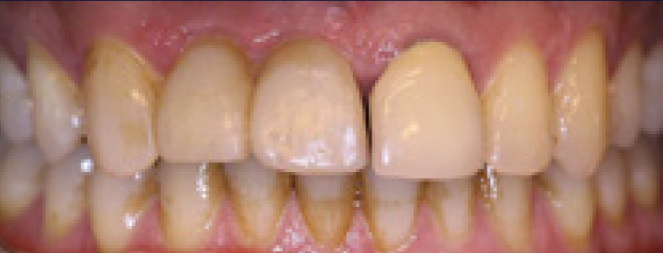 One week follow-up.
One week follow-up.
Note gingival healing and that there is no contact between provisional crowns and adjacent teeth.
 3 weeks follow-up.
3 weeks follow-up.
(Chlorhexidine stains on adjacent teeth)














Leave a Comment